Beef pho, or pho bo, is the most popular pho in the West. You can find it in every Vietnamese restaurant. If you are a fan of pho, you have probably noticed how the taste and quality vary from place to place. What makes or breaks pho is the broth. It takes time and quality ingredients to prepare. Authentic pho broth will captivate you with its aroma and taste that seamlessly combines salty, sweet, and umami all in one. Pho requires a methodical and complex preparation, but all that can be easily done at home, and it's so worth it. Once you try it once, you will be making it repeatedly.
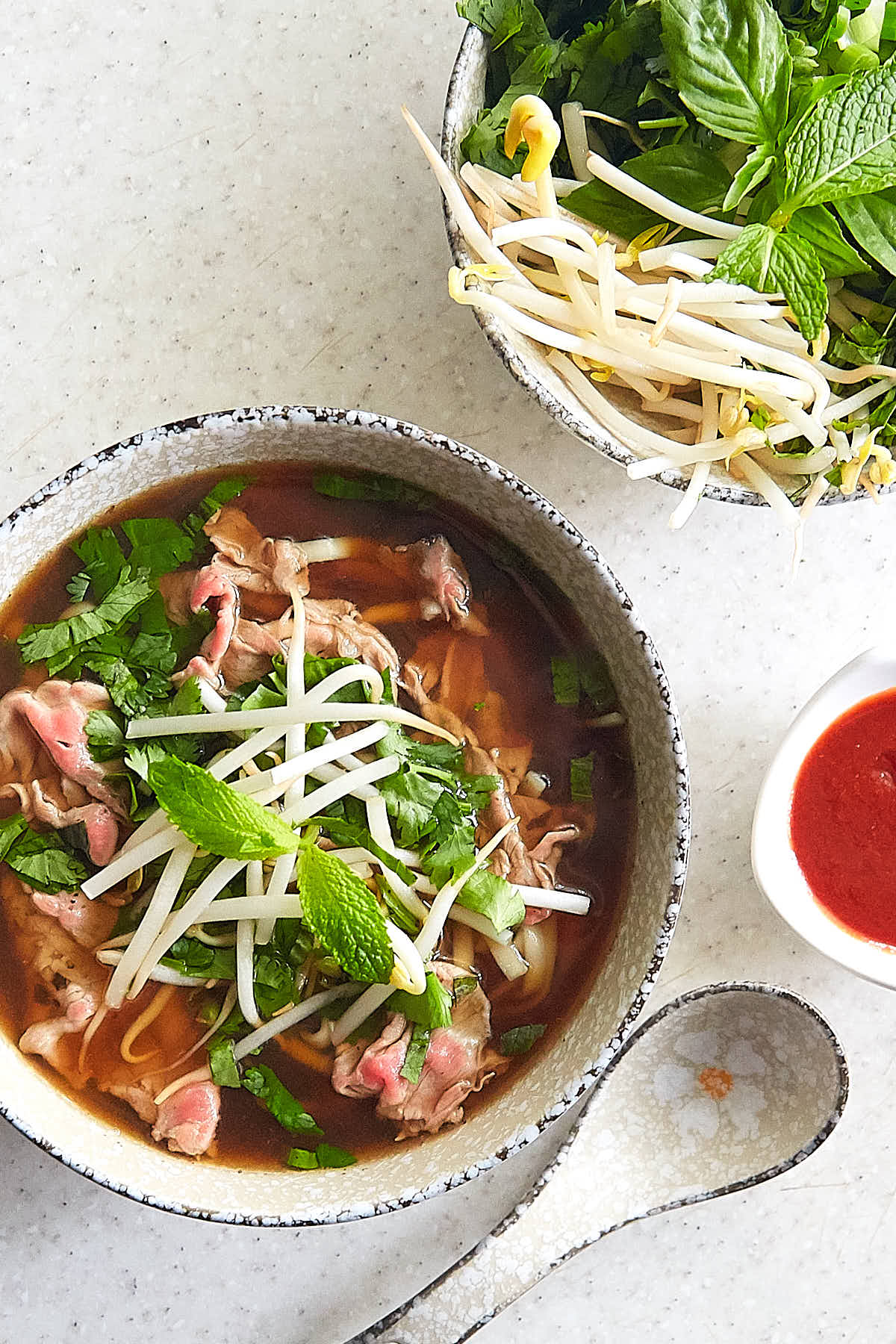
When I make pho the aroma of beef, cinnamon, star anise, ginger, roasted garlic, and onion fill the entire house, making everyone extremely hungry. The aroma is mind-blowing.
This recipe makes a full-bodied broth with a rich, multilayered flavor and taste. The broth has a dark amber color but clear. The longer it simmers, the more intensely flavored it becomes. The broth will taste very good after a couple of hours, but if you let it simmer for 10-12 hours, you will be blown away by the rich taste. This will make the ultimate pho bo. It will be so delicious that you will be thinking of making more the next day.
I like making beef pho on weekends, starting early in the morning and allowing it to cook for about 9-10 hours. This way, it will be ready just in time for dinner. Since I cook on the stovetop, I like to be around to check on pho every now and again, so no overnight cooks. I would be more comfortable with overnight cooks if using a slow cooker.
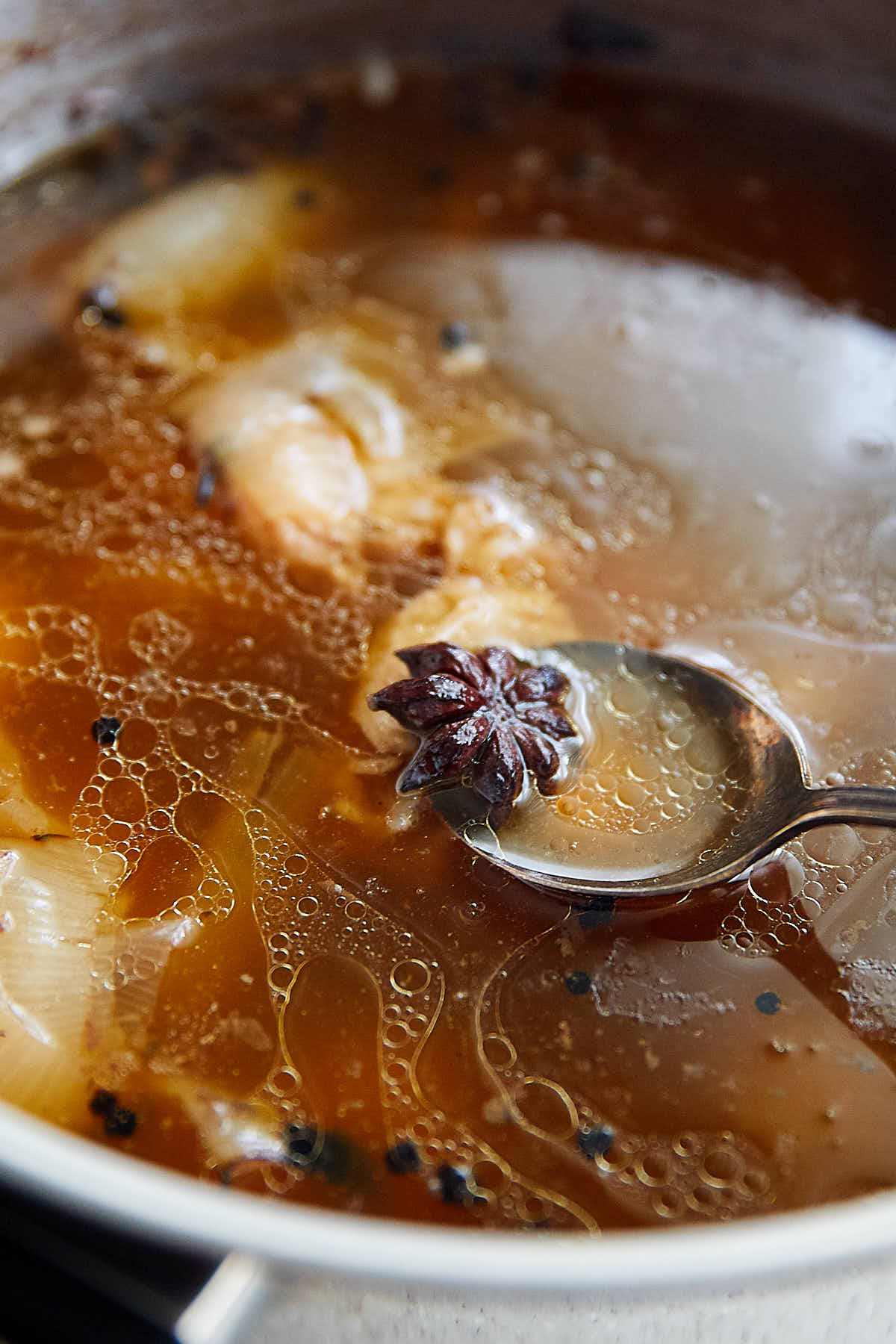
Beef pho assembly steps
Assembly of the pho bo starts with placing mounds of slipper rice noodles in a bowl, followed by paper-thin slices of raw beef eye round. Personally, I'll take ramen over rice noodles any time, and that's what I use in my pho. That's the beauty of homemade pho bo - you can completely customize it to your taste and create a masterpiece.
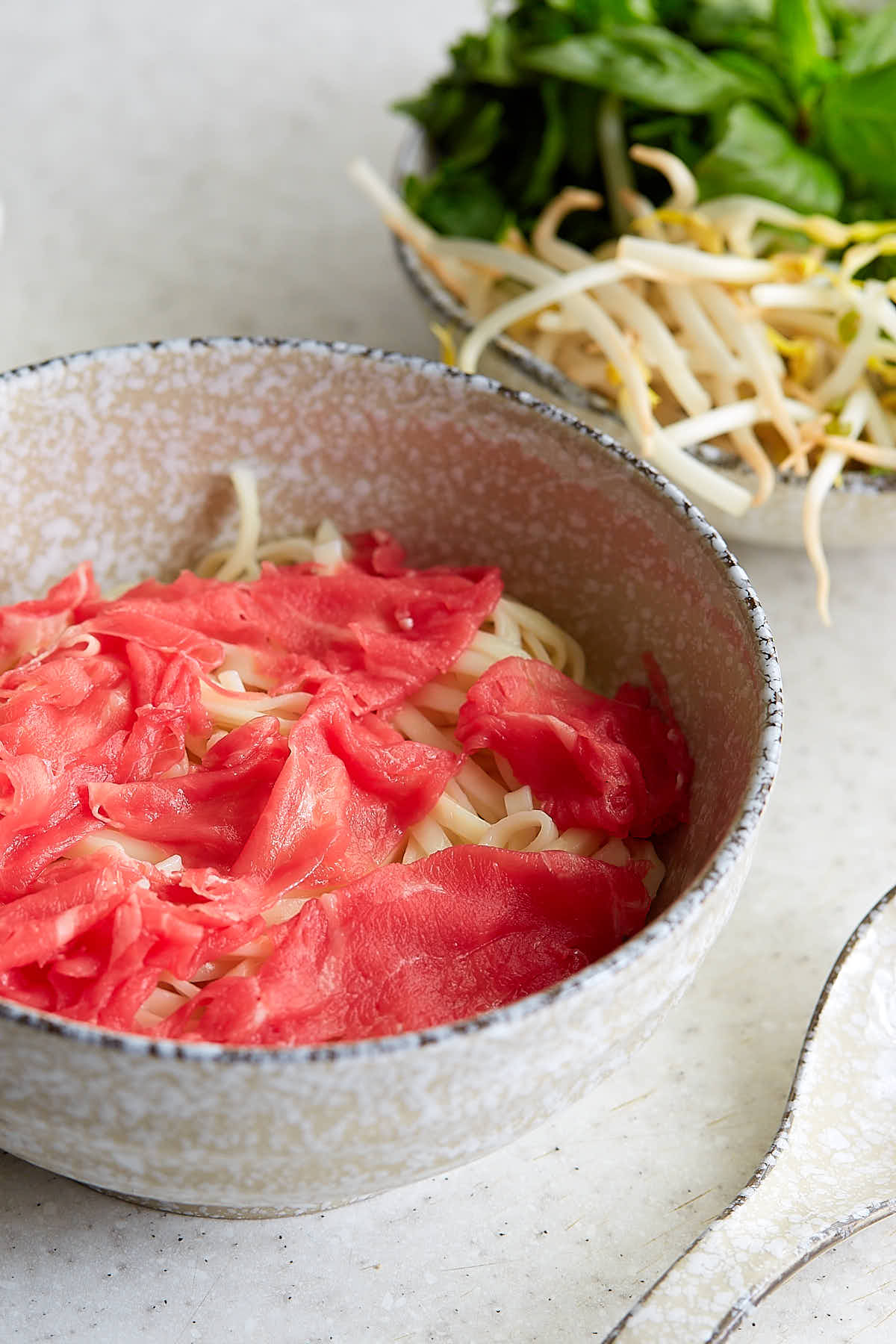
The next step is to pour boiling hot broth over the noodles and the meat. The hot broth will cook the raw thinly sliced meat to perfection - deliciously flavored and tender. Just make sure to cover the meat with the broth. Note that if you follow the recipe below, the picture above should also have bits of meat from the bones and thinly sliced onions and scallions arranged over the raw beef slices before pouring the broth. Things happen when trying cook, style, and take pictures simultaneously.
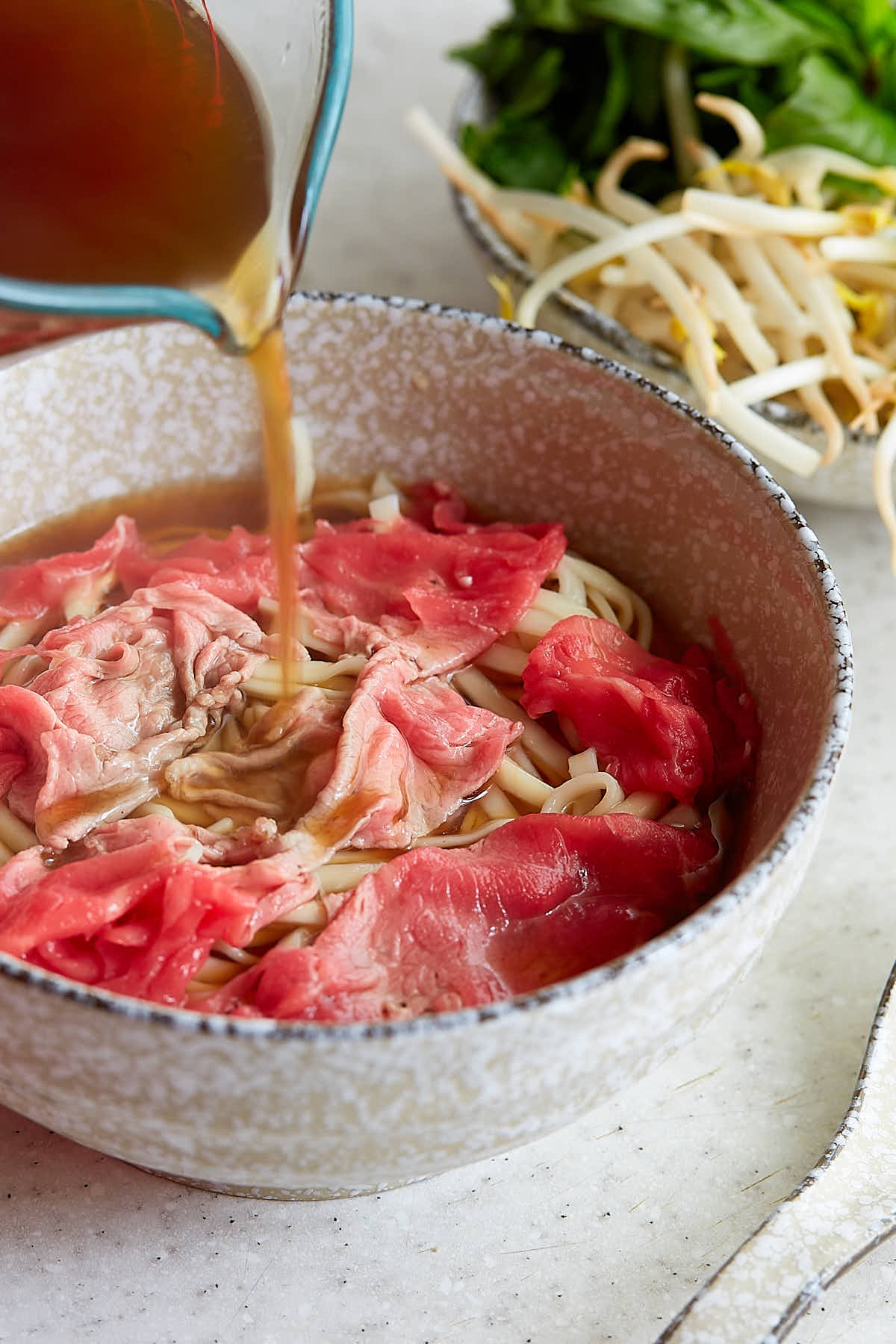
To enhance the finished dish, well-done flank, brisket, tendon, or tripe are sometimes added as well. The more meat, the better, right?
Finish the dish by garnishing it with bean sprouts, greens and squeezing some lime juice over it.
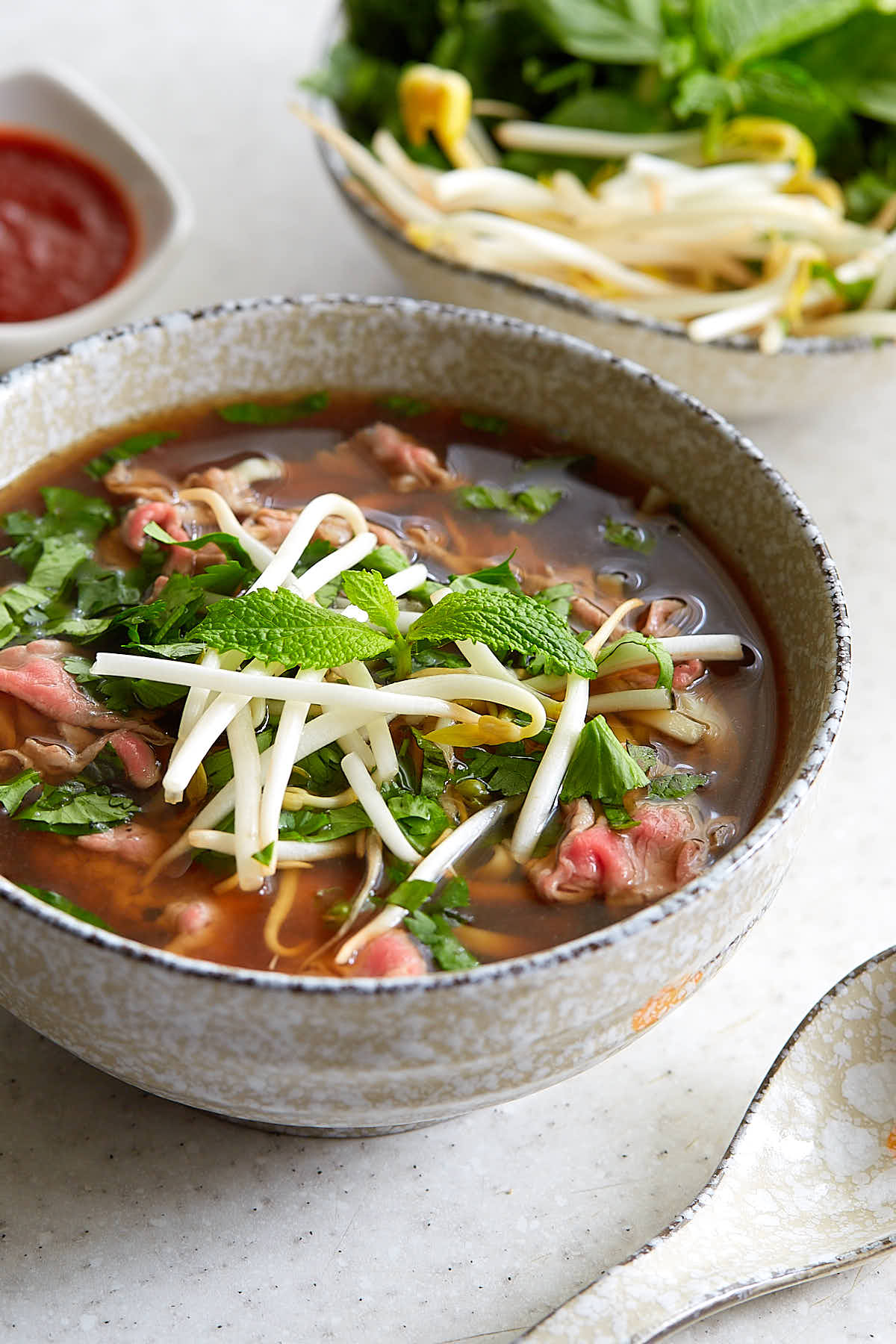
If you like your pho spicy add some sriracha on the side. Traditionally, hot sauces are served on the side not to spoil the broth's taste. Just dip a slice of meat into the sauce and eat it, followed by spoonfuls of delicious pho.
The recipe is originally from the Little Saigon Cookbook.

Ingredients
For the pho bo broth:
- 3 lbs beef knuckles or neck bones (with meat, see notes)
- 2 lbs beef oxtail (see notes)
- 10 cups water (or enough to entirely cover the meat)
- 2 large yellow onions (peeled)
- 1 fresh ginger root (½ size of a small palm, roughly peeled)
- 4 whole star anise (with pods)
- ½ Tbsp whole cloves
- 1 Tbsp black peppercorns
- 4 cloves garlic (smashed)
- 1 daikon (peeled and cut into 3 pieces)
- 1 cinnamon stick
- 3 small shallots (peeled)
- 1/2 cup fish sauce (see notes)
- 1 Tbsp salt (plus more to taste, the original recipe calls for 2 Tbsp)
For pho bo assembly:
- 12 oz flat rice noodles (pho noodles, see notes)
- 1 pound sirloin or top round steak (sliced paper-thin against the grain)
- 1 medium yellow onion (sliced paper-thin on a mandolin)
- 6 scallions (chopped into rings)
For the garnish:
- Sriracha chili sauce
- Hoisin sauce
- Fresh cilantro leaves
- Green limes (quartered)
- Mung bean sprouts
- Thai basil leaves
- Perilla leaves
- Coriander leaves
- Fresh whole red or green chiles
Instructions
- Place the beef bones and the oxtail in a large stockpot. Add the water. The bones should be completely covered with water. If not, add more. Bring to a boil and let the the bones boil while you are preparing the rest of the ingredients.
- Cut two peeled onions in half. Char each half by holding it with tongs over open flame of a gas stove or place it under the broiler. This will bring out the aroma and deepen the flavor of the broth. Repeat the same with the ginger and set aside.
- In a small skillet, lightly toast, frequently stirring, the anise pods. cloves, peppercorns, and garlic for about 5 minutes, or until fragrant. Set aside to cool.
- Check on the boiling bones in the stockpot and skim off any scum that has accumulated.
- Add the toasted spices and garlic, charred onion and ginger, daikon, cinnamon stick, and shallots to the stock. Boil for 15 minutes, then bring down to a gentle simmer.
- Add the rock sugar (optional), fish sauce, salt, and stir well. Continue to simmer for 2½ hours, uncovered, periodically skimming off any scum or fat as they accumulate. The broth will be ready to eat after 2 1/2 hours, but the longer you simmer the better it will become. Continue simmering, covered, for up to 10-12 hours in total for the ultimate pho bo.
- When the broth is done cooking, remove the pot from the heat and set aside to cool a little. Remove the bones and oxtails and set aside. You can use the meat and the bone marrow in the soup. Strain the broth through a fine mesh strainer into a new stockpot. The broth should be richly colored but clear. Bring the broth back to gentle simmer.
- Fill a large pot with hot tap water. Soak the rice noodles in the water for about 10 minutes. They should soften just slightly: the hot pho broth will cook them the rest of the way.
- Drain the noodles and place them in six individual soup bowls. Arrange the sliced raw beef on top, followed by thinly sliced onions and scallions.
- Slice the oxtail meat and add it to the bowl as well as any of the bits of meat and bone marrow taken from the bones.
- Pour the boiling hot broth into the soup bowls, making sure it covers the raw beef. The broth will cook the beef as well as the noodles. Give it a few minutes to do so, then serve with the pho garnish platter. A squeeze or two of lime juice will help cut the richness of the broth. The sauces can be added to the pho bo or used as a dipping sauce for beef. Using them as a dipping sauce will prevent from spoiling the wonderful flavor of the broth.
Notes
Nutrition
This post was updated on December 27, 2018


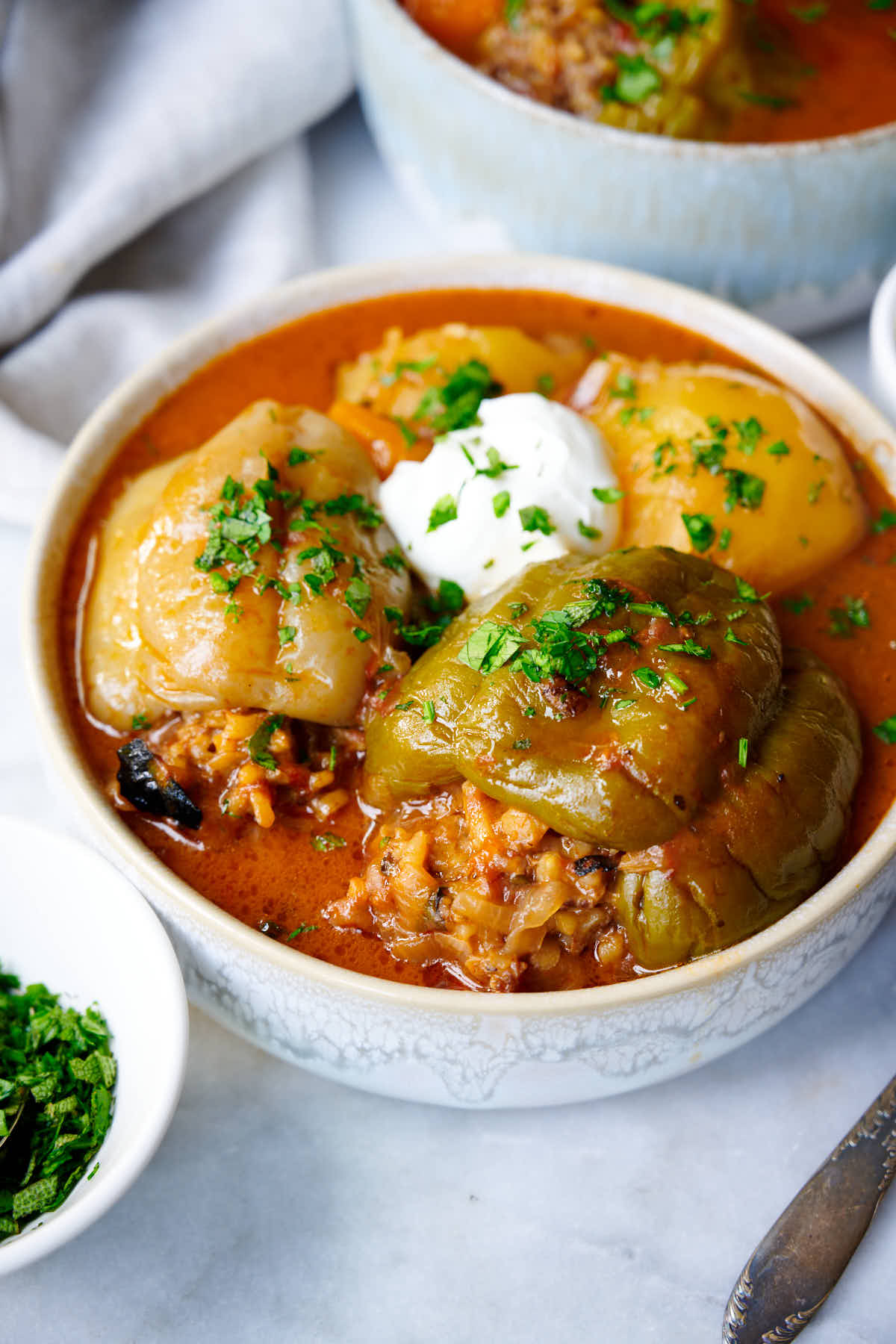
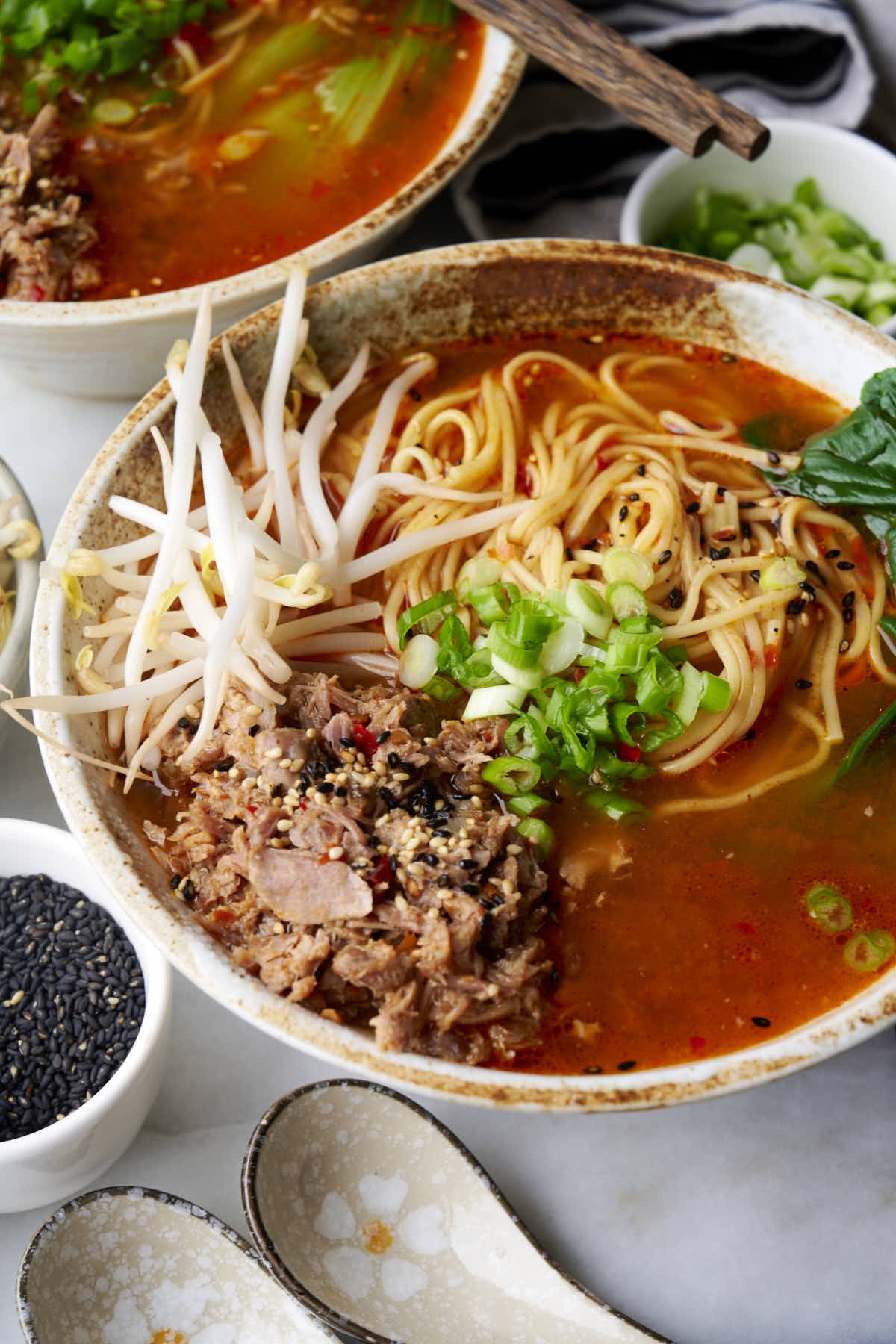

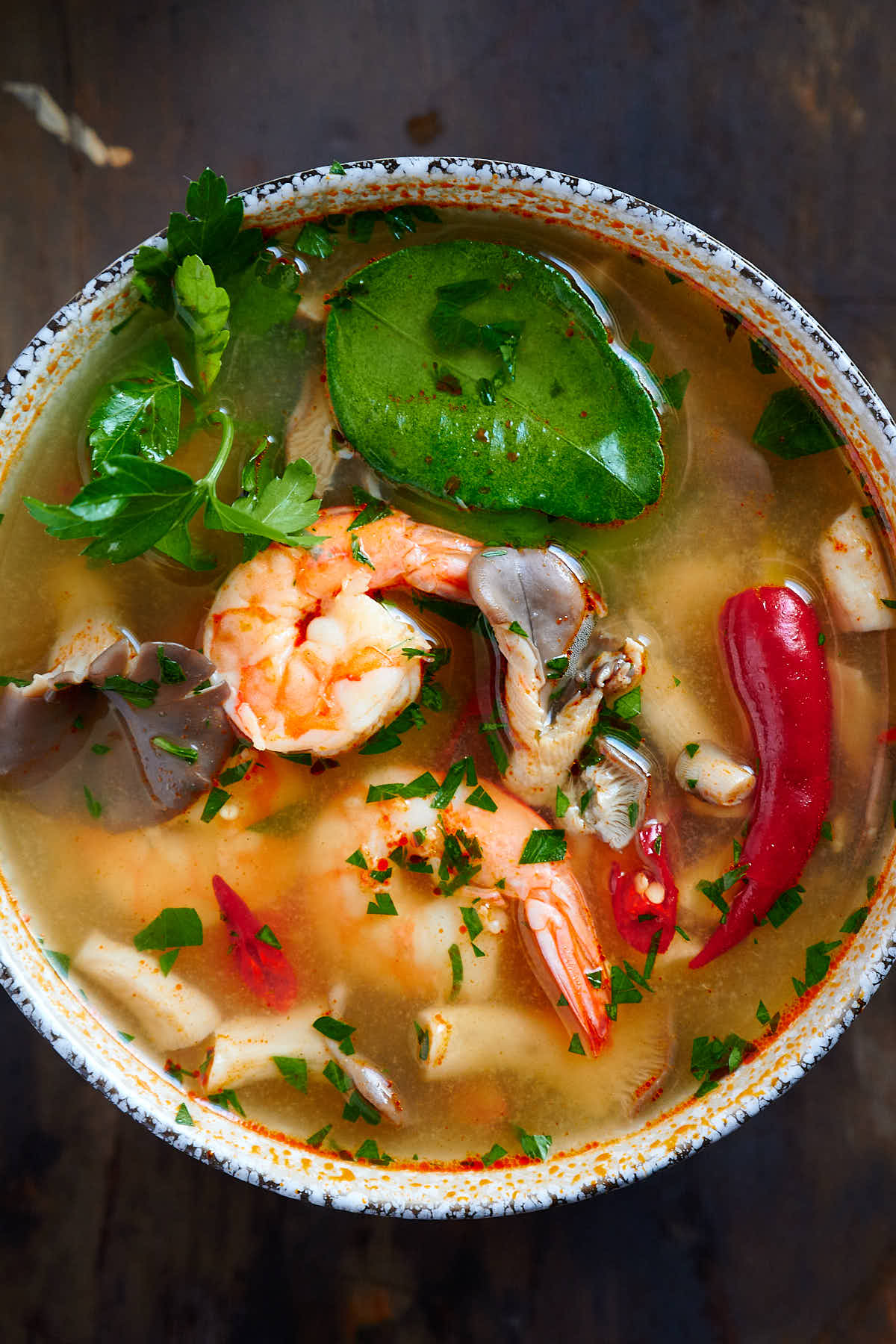
sonia says
I made this as a pho broth at the request of my daughter, who recently completed her radiation treatment for cancer. I had everything but daikon, also used oxtails, and since I was in a hurry, I used my InstaPot. Wow, divine! This is a keeper. Thank you!
victor says
You are very welcome, Sonia. Glad you liked my recipe. My best wishes to your daughter, lot's of health and happiness!
Roma says
Just made this and I’m in heaven! Sooo good. I did cheat a bit and used my pressure cooker and wow was it amazing.
Thank you for this wonderful recipe, I will be making this often!
victor says
Glad to hear it. Enjoy!
Yong says
Wow, fantastic recipe. So delicious!
victor says
Enjoy!
lacy lane says
I am making this today. I plan on cooking the broth alllllllll day. This is our NYE dinner and I am gonna make plain bao to go with it. Oxtails were pretty high, expense wise, so I'm going with neck bones and ham bones from the Christmas ham, because we aren't gonna waste that 🤣❤️
victor says
Enjoy! You will love it. I've been using beef shanks and love them. Only ask to cut them into 2" pices. Highly recommend them, make a fantastic Pho.
Felipe says
This is an outstanding pho recipe, the best I've ever tried and I've tried many as I love this soup. Highly recommend!
victor says
Glad to hear it. Enjoy!
Dan Simon says
I made this recipe twice, it's really the best pho I've ever tasted. Thank you very much for sharing!
victor says
Enjoy!
Jeanne says
Making this for the second time today. It smells incredible. After countless tries and disappointments with local restaurants I finally found the recipe my taste buds have been CRAVING. I also tried the ramen noodles last time and am now converted. THANK YOU THANK YOU THANK YOU!!!
victor says
You are very welcome. My family loves this soup. Lately, I've been making it with beef shanks exclusively. Just to my local Asian store, they have beef shanks on sale quite often, asked them to cut it 2 inches thick and there you have it, an amazing soup with plenty of tender meat. I serve with bones on the side for those who love bone marrow - delish.
Marianne says
I’ve been making this a few times per year since this post came out, after having a real pho craving, and this recipe tastes just like the one the old lady in the streets of Hanoi was making.
It’s amazing!
According to my husband, even better than the pho bo we had in Vietnam.
victor says
Glad to hear it, Marianne. This soup is a staple at our home. Everyone loves it. Lately, I've streamlined this recipe and made it a little easier to make, and more economical. I tie the spices in a piece of cheesecloth so it's easy to remove them at the end of cooking. I also go to the local Asian store and get a whole (skinless) beef shank that I aske them to cut about 1.5 inches thick, or in 4 pieces. It's great for making Pho broth, you get some bone marrow (my wife loves it), and you get plenty of meat for 4 even 6 servings. At the end, I just remove the meat from the bones and split between the serving bowls, add the broth and toppings. The meat is so tender and so flavorful that I don't want to make the soup any other way anymore. Highly recommend trying this.
Debs says
Hi! May I ask a question?
When simmering for 9-10 hrs, do you have to add more water to make up for lost in evaporation? If so, how many cups of broth should there be left in the pot to make 6 servings? Please let us know before I make this. Thank you so much! ☺
victor says
I keep it covered so most water stays in. The lid has a tiny hole through which some steam escapes but that's it. No need to add water. I never do. It should be a gentle simmer on one of the lowest settings on your stove so the evaporation is small to begin with.
Annie E says
This pho is really good. Better than any restaurant nearby. It does call for too much salt though. I think 1-2 tsps is enough. I don't understand how the original recipe could have called for 2 tbsp. I could understand 2 tsps. I love a lot of salt, but that's just too much.
Ben Bruner says
Made this dish for my son. We both appreciate authenticity. This one is spot on. As stated it does take 8 to 12 hours for the magic to happen but soooo
worth it. Good things come to those who wait! Please note I’m note boasting on my skills but this recipe was the best I’ve tried
Brittney D says
Pho has been one of my favorite dishes since I first tried it about 2 years ago ! I have NEEDED it in my life at least once every other week and have tried many restaurants. I have only Come across 2 or 3 that are really good. This pho recipe followed step by step and allowing the time to simmer for hours made an amazing broth ! I love it and I also did not use the oxtail .. although im not sure what using it would taste like But i can tell you I am not disappointed one bit with the outcome not using it ...this is great .. thank you for sharing!
victor says
You are very welcome. Glad you liked our pho recipe.
Bruce says
Did my soup/stock base after cooking it for 9.5 hours, and made about 9 big bowls of pho from it, and very good. From my experience with chinese beef noodle soup, I added some baby bok choy for more veg content, and for my wife who doesn't like beef replaced the tender beef slices with fish balls, and also came out good. If the stock is rich, then adding more flavour with sauces and sate makes it all worth the trouble. Next time I'll pump up the stock with more spices - coriander and fennel - to deepen flavours. Thanks, Victor, with this preparation. Soo cool!
Ym says
I made Phở Bò and sometimes I do make Phở Gà (chicken). I like your phở a lot. Just reading the ingredients I knew I got a righ recipe.
Thank you.
victor says
Thank you. I get a lot of praises for it.
Jim says
First time making “Fu”. This recipe did not disappoint! The family loved it as did I! My only draw back was, the noodles I used did not soften up from the boiling broth. I pre soaked them for 25 minutes. Maybe my water was not hot enough to tender them up. I ended up boiling them for a couple minutes and bam!
victor says
Thanks for the feedback, Jim. I also had some problems with rice noodles. More so, I don't enjoy them too much as they are quite bland. I now use pre-cooked Japanese ramen noodles and everyone loves them. It's not authentic but very tasty.
Linda says
This recipe was awesome. I made it without the ox tail and fish sauce and my husband said it tasted better than my moms! My mom is an awesome cook so that was quite the compliment. Also, my entire home smelled like a pho restaurant.
victor says
Fantastic! So good to hear that and I am not surprised. I tried Pho at several restaurants and I can't help but think that this recipe makes a much more flavorful and thicker broth. I like to simmer mine for 8-10 hours for best results.
Bruce says
I think restaurants reflect the culture they are set up in? I have lived in Asia, but as a Canadian living in western Canada, I've tried about 20 Vietnamese restos in Calgary, and except for 2, they all offer bland pho with marginally okay broths, and big plastic bottles of sauces on the tables to counter the low quality flavour in their pho. Thanks, Victor, for the encouragement to cook the base broth for much of the day before making completing the soup. As I've already done spicy beef noodle soup Taiwanese style, I now know that the ingredients with patience helps make a soup that's just as good as most restaurants. So now I will try a pho with a broth that from soup bones should make one's ears stand up straight and dance all day....
Jen says
OMG! That picture of the broth makes me so hungry!